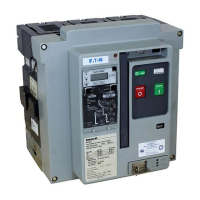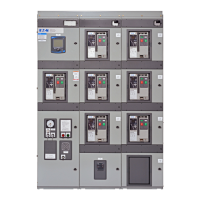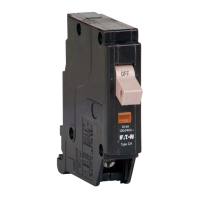62
Maintenance, testing, and operating conditions
MAGNUM PXR PRODUCT GUIDE PA013006EN September 2022 www.eaton.com
6
Maintenance, testing, and
operating conditions
Maintenance schedule
Normal maintenance
Shown in Table 23 is a baseline for developing a
maintenance schedule. This recommendation is based
on normal operating conditions (outlined in following
sections). When determining the breaker maintenance
schedule, actual environmental and operating conditions
should be taken into consideration. Magnum PXR break-
ers are tested to meet and exceed ANSI/IEEE C37.16.
For instruction on inspection process, see Magnum PXR
manual MN013016EN.
Table 23. Normal maintenance frquency
Test / inspection Frequency
Arc chute inspection 1 year
Primary contact inspection 1 year or after a short circuit
interruption
Internal mechanism inspection Every 250 operations or 3 years
Primary disconnect inspection
(drawout applications only)
Every time breaker is racked out
Secondary connection inspection Every time breaker is racked out
Interlocks inspection Every 250 operations or 3 years
Trip unit testing (primary injection) 5 years
Trip unit testing (secondary injection) 2–3 years
Table 24. Endurance requirments for low-voltage AC
power circuit breakers (see ANSI C37.50)
Circuit
breaker
frame size
amperes
Number of make-break or close-open operations
Between
servicing
Electrical
endurance
Mechanical
endurance
Total
endurance
600 1,750 2,800 9,700 12,500
800 1,750 2,800 9,700 12,500
1,600 500 800 3,200 4,000
2,000 500 800 3,200 4,000
3,000 250 400 1,100 1,500
3,200 250 400 1,100 1,500
4,000 250 400 1,100 1,500
5,000 250 400 1,100 1,500
a
Servicing shall consist of adjusting, cleaning, lubricating, and tightening.
Increased maintenance
Although Magnum breakers are designed and manu-
factured to operate in a wide variety of applications and
environments, there are some conditions that may require
inspection frequency to be increased. See Table 25 for
conditions and recommended actions.
Table 25. Increased maintenance frequency
Factor Condition limits Recommended action
Operating conditions
Frequency
High cycling Greater than one operation
every 2 minutes
Inspect every 1500
operations
Low cycling Less than one operation
per year
Double the normal
inspection frequency
Repeated
interruptions or
overloads
Three interruptions or 50
overloads (28 overloads for
>2000 A breakers)
Double the normal
inspection frequency
Capacitive
switching
>135% of the capacitive
bank load
Double the normal
inspection frequency
Environmental conditions
Temperature Ambient temperature is
above or below 15°C to
30°C (59°F to 86°F)
Double the normal
inspection frequency
Temperature Breaker is placed in an
area with a strong solar
influence
Double the normal
inspection frequency
Dirt and
contaminants
Visible dirt or contaminants Remove contaminants from
the breaker and double
the normal inspection
frequency
Corrosive
atmospheres
Breaker is used in water
or wastewater, pulp and
paper, petrochemical,
or other harsh industrial
atmospheres
Double the normal
inspection frequency
Altitude >2000 m (6562 ft) Use appropriate voltage
and current correction
factors. See Table 30 for
rating factors. Short circuit
current is not affected as
long as the voltage is rated
in accordance with the
table.
Humidity Breaker is placed in a
condensing environment
Double the normal
inspection frequency and
inspect for rust

